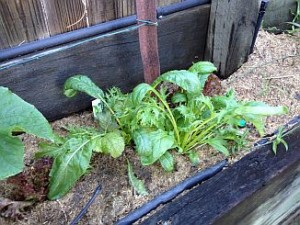Growing Your Veggies in Raised Beds
Raised garden beds come in many forms and can be very useful in certain situations…
 Sometimes it comes from a rise in food prices, other times it is the result of reduced circumstances. It can even come from a desire to improve the quality of the food you eat. Whatever the reason, many people each year start a vegetable garden; one popular type of garden chosen is a raised bed vegetable garden. Many others, who have gardened for years, choose to change their method of gardening to raised beds for the increased convenience.
Sometimes it comes from a rise in food prices, other times it is the result of reduced circumstances. It can even come from a desire to improve the quality of the food you eat. Whatever the reason, many people each year start a vegetable garden; one popular type of garden chosen is a raised bed vegetable garden. Many others, who have gardened for years, choose to change their method of gardening to raised beds for the increased convenience.
Raised beds are usually no wider than four feet so that the gardener can reach the middle while remaining outside the bed. In theory, the beds can be as long as one likes but usually they are no longer than 12 feet and are often as little as 4 foot square. Smaller beds look more aesthetically appealing, take up less space and are easier to monitor for ripe produce, pests and weeds.
It is important to remember when planning a raised bed garden that ample space needs to be left between the beds so that a garden cart or, if necessary, a lawn mower can fit between them.
Benefits
Frost protection – In a raised bed garden protecting tender plants in the spring is easier to accomplish than in a traditional garden. The beds can be covered without having to walk a great distance or traipsing through mud.
Improved Drainage – Soil in a raised bed drains more quickly which allows plant roots to breathe rather than sit in soggy soil.
Less back strain – Raised beds mean less bending although how much less depends on the height of the beds.
Less weeding – Raised beds are troubled less by weeds. They have difficulty taking hold and the walls of the bed keep out garden turf.

Less work – Less weeding, less bending and, once established, little in the way of preparation each season. The soil, never walk
ed upon, therefore never becomes compacted.
Warms up earlier – Soil in a raised bed warms up faster for an earlier start to the gardening season.
Increased Productivity – Better drainage combined with fewer weeds to compete with means healthy plants that produce more ve
getables.
Vegetable Choices
Not all vegetables are good choices for raised beds, although technically. any vegetable can be grown in them. Ideally, someone new to raised bed gardening should start with the best choices for this type of gardening and then branch out if they wish.
[easyazon_block add_to_cart=”default” align=”right” asin=”B0055FSKPW” cloaking=”default” layout=”top” localization=”default” locale=”US” nofollow=”default” new_window=”default” tag=”urbgardesazn-20″]
Best Veggies:
- Carrots
- Radishes
- Lettuce
- Beets
- Cabbage
- Broccoli
- Cauliflower
- Zucchini/ summer squash
- Peppers
Questionable Veggies:
- Cucumbers
- Peas
- Tomatoes
These are questionable because they either require staking or need a trellis. Because soil in a raised bed has a high degree of friability, it is difficult for a trellis or stake to provide a sturdy enough support. One option is to have the trellis or stakes outside bed, if the walls are narrow enough for this to work.
Worst Veggies:
- Pumpkin
- Watermelon
- Sweet potatoes
- Irish potatoes
- Corn
These plants either take up too much room, need hilling (potatoes) or are too tall (corn) and may not be able to hold themselves upright due to the nature of the soil in a raised bed.
I’m not that much of a internet reader to be honest but your blogs really nice, keep it up! I am just trying to get a home garden started, so I’ll go ahead and bookmark your website to come back in the future. Cheers